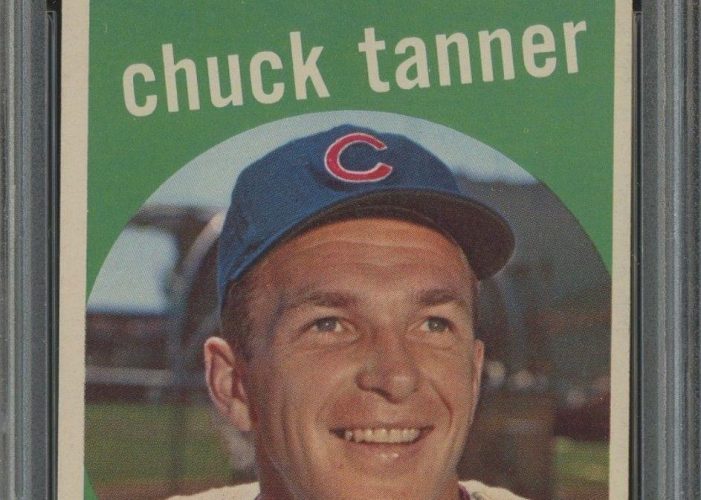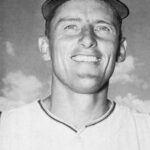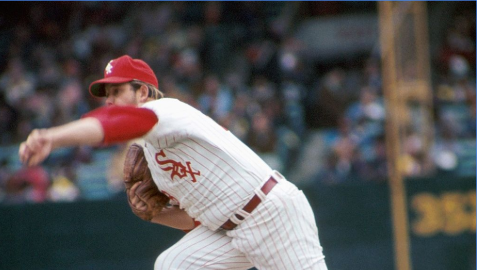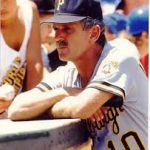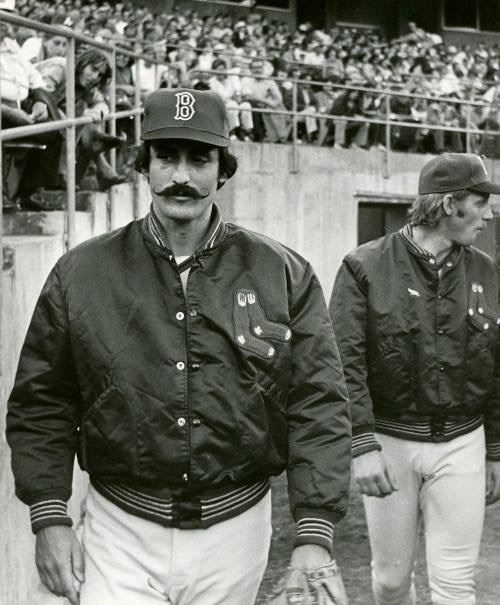Chuck Tanner
Positions: Leftfielder and Pinch Hitter
Bats: Left • Throws: Left 6-0, 185lb (183cm, 83kg)
Born: July 4, 1928 in New Castle, PA
Died: February 11, 2011 in New Castle, PA
Buried: Castleview Memorial Gardens, New Castle, PA
High School: Shenango HS (New Castle, PA)
Debut: April 12, 1955 (11,204th in major league history) vs. CIN 1 AB, 1 H, 1 HR, 1 RBI, 0 SB
Last Game: May 8, 1962 vs. DET 1 AB, 0 H, 0 HR, 0 RBI, 0 SB
Full Name: Charles William Tanner
View Player Info from the B-R Bullpen View Player Bio from the SABR BioProject
Relatives: Father of Bruce Tanner
Nine Players Who Debuted in 1955
Brooks Robinson
Roberto Clemente
Ken Boyer
Rocky Colavito
Clete Boyer
Elston Howard
Sandy Koufax
Jim Bunning
Bill Virdon
All-Time Teammate Team
Coming Soon
Notable Events and Chronology
Few figures in the history of major league baseball were as optimistic as former Pirate manager Chuck Tanner. A master of proactivity long before Steven Covey made a fortune preaching it’s merited, Tanner helped teams overachieve in every city he managed by focusing on his players’ strengths and praising them to the media. He not only led the Pirates to a World Championship but helped the team rebound from a disappointing 1981 to be a contender in 1982 and 1983 before some of his charges took advantage of his faith that they would carry themselves with respect for their abilities and the expectations of their employers. As his former team captain, Bill Madlock once
said, “Chuck’s downfall was that he treated his ballplayers like men.”
Tanner was a natural to replace Danny Murtaugh when the Pirate manager retired for a final time in 1976. New general manager Harding “Pete” Peterson had one problem blocking his way in bringing Tanner to Pittsburgh. The manager was already under contract with the Oakland A’s. A’s owner Charlie O. Finley made it known Tanner was available, but he wasn’t going to give the skipper away. The A’s, a powerhouse during the early 1970’s, had been decimated by free agency and Finley was desperate for players. He insisted on receiving .300 hitting catcher Manny Sanguillen and a large sum of cash in return for Tanner. Peterson decided having one of baseball’s best managers was worth the price and made the trade, the first time a player was traded for a non-playing manager.
Tanner’s reputation was well deserved. Born in New Castle, only 40 miles north of Pittsburgh, Tanner began his career as an outfielder in the Boston Braves’ organization, signing with them in 1946 after starring in baseball, basketball and football for Shanango High School. Tanner’s enthusiasm was put through a long test as it took him nine years to reach the majors, but he quickly found playing in the big leagues was worth the wait when he hit the first pitch he ever saw for a homerun. Tanner’s shot came off the Reds’ Gary Staley, but while he spent at least parts of eight other seasons in the majors, the lefthanded hitter added only 20 more in his career. He retired with a .261 batting average.
Tanner’s first managerial experience came in the Angels’ organization with Quad Cities in the Midwest League in 1963. He further developed patience by managing in the minors for another seven years, but when he won his second minor league championship with Hawaii in the Pacific Coast League in 1970, Roland Hemond hired him to manage the White Sox, replacing Jimmy Adair, serving as an interim boss after Don Gutteridge had been fired with a 49-89 record. Tanner went just 3-13 over the final 16 games to close out 1970, but his White Sox improved by 23 games in 1971, and in ’72, Tanner led Chicago to a surprisingly strong second place finish. He was voted Manager of the Year in the American League, although he preferred to give credit for the team’s success to Dick Allen, the controversial first baseman who Tanner was able to work with as no manager had before. Tanner won acclaim for his ability to communicate with his players, his use of the running game and his fearless gambles with his pitching staff, such as moving ace reliever Wilbur Wood to the starting rotation, where he became the game’s most durable pitcher, and going with hard-throwing rookies like Terry Forster and Rich Gossage in the bullpen.
While he remained popular even when the ChiSox slid back in the standings, Tanner turned down a proposal that would have removed him from his manager’s role into a front office position in 1976. Bill Veek, who had purchased the team, decided to bring Paul Richards out of retirement and offered Tanner another position, with the promise he would return to the manager’s role once Richards stepped down. But Tanner wanted to continue as an onfield leader instead and signed with Finley to manage the A’s.
While the White Sox ran a lot under Tanner, it was nothing compared to the thievery procured by the A’s during Tanner’s year in the City by the Bay. The A’s stole 341 bases, the most ever in the AL and the highest total in baseball since the 1911 Giants stole 347, almost taking the Western Division as well.
With his western Pennsylvania roots and the Pirates having found the running game in ’76, Tanner was welcomed in Pittsburgh. His influence on player decisions was also felt as Peterson acquired three players Tanner was very familiar with, Forster, Gossage and Phil Garner, shortly after Chuck’s homecoming. The Pirates played well under him in 1977, winning 96 games, the most by a Pirate team since their 1971 World Championship. Tanner’s perseverance helped keep the 1978 team from giving up even when it fell 11 ½ games out of first on August 12, 1978.
He rallied the Bucs to a close second-place finish. During this time, he stuck with the struggling hitting of Omar Moreno, brought pitcher Don Robinson up from AA and continued to accentuate the Pirates’ running game and bullpen. In 1979, “Chuck’s Bucs” were again involved in a tight pennant race. He made several gutsy calls that season, such as playing pitcher Kent Tekulve in leftfield for one batter during the heat of the pennant race so that he could bring the ace reliever back into the game if it did not end with the next batter. The game did, but only after Tekulve caught the batter’s flyball. In the playoffs, Tanner turned to the hard-throwing Robinson, usually a starter, to Pitch out of jams in the first two games and in the World Series he wisely chose Manny Sanguillen, who Peterson had re-obtained, to pinch hit with the go-ahead run at second in the ninth inning despite Sanguillen having only driven in four runs all year. The bad ball hitter delivered a base hit to win the game. Afterwards, Tanner explained he chose Sanguillen because he figured Manny could handle pitcher Don Stenhouse’s deliveries which tended to tail out of the strike zone. Tanner called on another veteran who did not have a particularly good 1979 in Jim Rooker to start Game 5 of the Series with the Pirates facing elimination. Tanner recognized Rooker, a gritty competitor, had pitched well in September after finally regaining his health in what had been an injury-plagued year. The lefthander came through with five strong innings to give the Pirates the opportunity to win the game. What might have been his strongest personal statement, however, was the courage he showed in leading the Bucs back from a three games to one deficit after finding out his mother had passed away the morning of Game 5.
Tanner’s team was hit hard by injuries in 1980 and his style of handling his pitching staff was criticized by one of his aces, Bert Blyleven, who hated Tanner’s quick hook and his insistence on a five-man rotation. After his World Series team began to age in 1981 and the team played poorly after the strike, the Pirates were put into a retooling mode. Tanner, however, refused to concede the team could not contend and after rocky starts, managed the club into pennant races in 1982 and 1983.
The Pirates, however, struggled during Tanner’s last two seasons in Pittsburgh, finishing last both years. His club had no hitting in 1984 and in 1985 clubhouse morale had become terrible. To make matters worse, late in the season, it became public knowledge that several of the players who had worn Pirate uniforms over the past few years had used drugs. Tanner was criticized for being too lenient with his players, but Tanner had never been one to intrude in his player’s personal lives and had gotten excellent performances from his men by leaving the players alone, rather than trying to tightly control them. In the end, Tanner realized he would not be invited back in 1986 and advised his coaches to prepare themselves to look elsewhere for employment following the season. But even with two cellar finishes, Tanner’s talents for turning teams around remained respected and he was hired by the Atlanta Braves where he managed for 2 ½ years before becoming a scout for the Milwaukee Brewers.
Factoids, Quotes, Milestones and Odd Facts
Coming soon
Other Resources & Links
Coming Soon
If you would like to add a link or add information for player pages, please contact us here.

